Starting the Young Horse Over Fences
by Holly Peterson
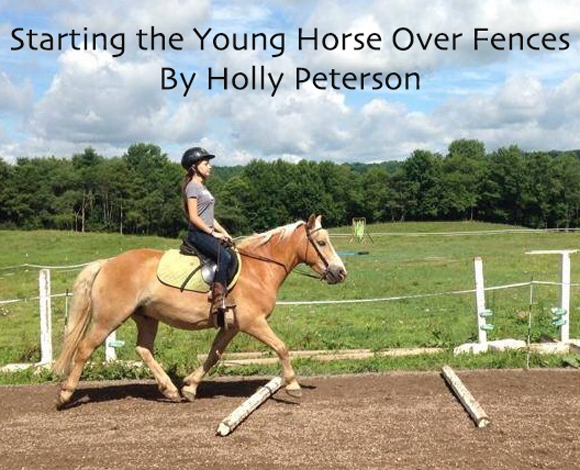
When starting a young horse over fences, it’s important to make sure their experiences are positive ones. It involves much more than just pointing them at a jump and sending them over. Giving them a solid foundation to start their jumping career will help make them happy confident jumpers in the future. Factors to consider when starting the young horse; the rider, horses maturity and the horses level of training.
Starting with the rider, the rider should have a calm, confident demeanor, steady aids, a balanced 2-point position and quiet hands. Attitude during these training 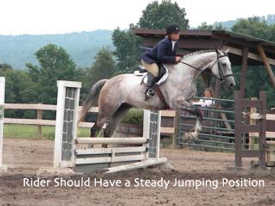 sessions are so important. Riders should not get angry and aggressive if the horse doesn’t ‘do’ what they are supposed to. They may not understand what’s being asked of them or are fearful. Anger from their rider will only confuse them and aggression will make them fearful of the task at hand. Would you follow the directions of someone screaming and hitting you when you’re trying something new? Or would you listen to the person explaining it quietly and repeating the instructions and guiding you until you understand? The more relaxed the rider, the easier it is for the horse to relax.
sessions are so important. Riders should not get angry and aggressive if the horse doesn’t ‘do’ what they are supposed to. They may not understand what’s being asked of them or are fearful. Anger from their rider will only confuse them and aggression will make them fearful of the task at hand. Would you follow the directions of someone screaming and hitting you when you’re trying something new? Or would you listen to the person explaining it quietly and repeating the instructions and guiding you until you understand? The more relaxed the rider, the easier it is for the horse to relax.
The riders’ position is also important. If the rider is unsteady in their position, jumping up the horses’ neck or losing their balance upon landing, the horse will have a much harder time finding their own balance. Maintaining a steady position allows the horse to find their balance without interference from the rider. The goal at this point it to develop their confidence over fences, there is time to fine tune the jump later.
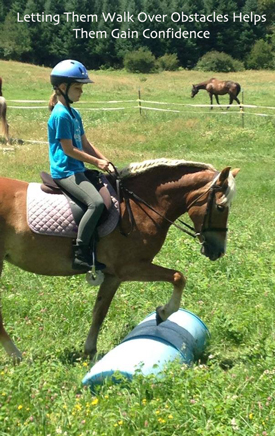 A rider should never balance off their hands, but especially with a young horse: snatching them in the mouth can cause them to be fearful, resistant and defensive. While you don’t want to throw them away, you do need to have a quiet steady communication with the horse.
A rider should never balance off their hands, but especially with a young horse: snatching them in the mouth can cause them to be fearful, resistant and defensive. While you don’t want to throw them away, you do need to have a quiet steady communication with the horse.
The horse's maturity level is also an important factor in deciding if the horse is even ready to start jumping. One of the most common mistakes, when starting the young horse, is starting them over fences before they are ready; mentally or physically. Physical age should be a huge factor as to when a horse should be started.
Personally, I never start any horse to jumping before the age of 4 as they are still growing. Even at 4 years old the focus is on building their confidence over fences through slow and steady repetition. Horses don’t fully mature physically until they between the ages of 5 and 7 years old. Jumping a horse at a young age can not only limit the longevity of their jumping career, but makes them susceptible to injury, arthritis and joint damage. There are so many studies and so much evidence which show just how damaging it can be for a young horse to be worked too hard to early. Babies under the age of 4 should never be jumped with a rider, jumping them through a chute should be kept to an absolute minimum. Unless you can jump it - babies 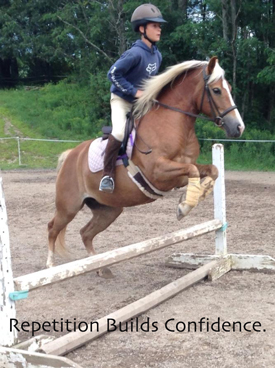 shouldn’t be jumping it.
shouldn’t be jumping it.
Mentally maturity, is your horse ready? As we all know not all horse mature at the same rate, some horses mentally mature faster than others. If they have reached an appropriate age, they seem confident with new things; then they are probably ready to move forward to jumping. If simple stuff on the flat still blows their minds- they aren’t ready yet. Keep working on their basics.
The last thing to consider before starting jump training is their level of training. A young horse that does not first have a solid basic flatwork foundation should never be started over fences. If they are barely controlled at the walk, trot, and/or canter, they aren’t steering well, not going forward on cue; they just aren’t ready. Putting them to fences before they have the basics can be dangerous for them and you. They should be able to walk, trot, canter, steer and halt in a controlled manner before starting jump training.
Once it has been determined that your horse is ready to start jumping mentally, physically and they have their basics, the next question is: Where to start.
What is one of the first things we teach a horse to do? We teach them to lead. A great way to introduce the young horse to fences is to lead them over the obstacles. It is a great confidence building exercise. It gives the young horse a chance to investigate the obstacle, it lessens the impact on their joints from a rider and helps build their trust in you. Start with just a pole on the ground and build from there to x-rails, logs, and little flower boxes. If they are going to resist while you are leading them, they are going to resist while you’re on them. As this is a low impact way to introduce a young horse to fences, you can do these types of exercises long before you start riding them without hurting them.
Once they are comfortably leading over obstacles with no resistance, they are probably ready to start with a rider. Start small and simple. Always start by walking; they need to walk before they can run. Ground poles are about as low and as easy as you can get. Start with a single pole and ask them to walk over it. Do lots of big open changes of direction. Once they are comfortable walking over the pole, maintaining rhythm and impulsion going over it, then ask them to trot over it. Ground poles are also a great way to teach the young horse not only to pick-up their feet, it is really good for strengthening their stifles. As you add poles to the lineup, make sure you adjust the width of the poles to accommodate your horses’ length of stride. They should be set approximately 4 to 4 ½ feet apart.
Cross rails are the next step. Let them look at the fence - lead them over it if they seem really fearful of it. Again, let them walk over them several times before asking them to trot over them. It’s ok to let them plod over them to start. They are learning to pick up their feet over obstacles, so it’s not necessary for them to leap them like it’s a 4’ fence just yet.
Don’t rush through doing single fences. Make sure they are comfortable and consistent before asking them to do a line. If they are rushing, stopping or inconsistent with a single fence, it’s not going to improve by adding more. Once they are going over the cross-rail easily, start asking them to listen to you as they do it. Simple exercises such as - walk in, trot out; trot in, canter out; canter in, canter out.
When they are solid over a single, and they aren’t rushing in or away from it, you can start to add another fence- one at a time. At each step making sure they are solid before adding another fence, until they are able to complete a course.
At this point you can start adding small verticals. You can either start with a single or do a cross-rail to a vertical line. I recommend a very low vertical to start as this is going to look different to them; generally no higher than the lowest point on your cross-rails. This way if there is an issue and they get a little scared you can walk over it.
Over facing a young horse is a pretty common mistake but can make for big problems. Many riders get bored with the “little stuff” and move their horses up too high too fast. This will often overwhelm the young horse and they will start to develop issues such as running out, rushing to or away from the fence and baulking. Give them time to become 100% solid and to develop their confidence over the small stuff before moving them up. Developing a solid jumping partner is not a quick process- it takes time and patience.
Balking - they are trying to tell you something. You should never beat/hit/whip any horse for not going over a fence, but most definitely not a young one. They stopped for a reason. Reasons that can include fear, pain, lack of understanding, they are overwhelmed or over-jumped. Take them back down to a level they were comfortable at and start again. The goal is to get the young horse comfortable going over what ever you ask them to. This will not be achieved by rushing them through the steps. Just because they can jump higher, faster, quicker; doesn’t mean they should.
Rushing to or from fences is also an indicator that something isn’t right for your horse. If you have put the time into their foundation and jumping basics, they shouldn’t be rushing. There are many reasons for them to rush including pain, fear, rider error, and excitement. There are many horses that truly love to jump and get excited and rush, however if they have a solid foundation they should be fairly easily controlled.
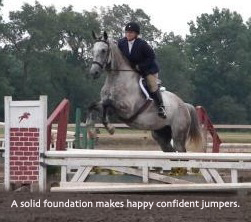 How do you know they are ready to move to the next level? They tell you. They tell you by maintaining a steady rhythm over the fences you put them to; canter-canter-jump- canter-canter. It’s rhythmic, steady and you don’t feel like you have to push or struggle to keep them on task.
How do you know they are ready to move to the next level? They tell you. They tell you by maintaining a steady rhythm over the fences you put them to; canter-canter-jump- canter-canter. It’s rhythmic, steady and you don’t feel like you have to push or struggle to keep them on task.
The end goal is to have a quiet willing partner that’s happy and willing to jump. Giving them a solid foundation to start their jumping career will help make them a happy willing partner for many years to come. Slow and steady builds happy confident jumpers.


